Strongman Physique: What Is A Strongman’s Body Type?
Author:
Unlock your full potential by engaging with our experts and community! Have questions about your fitness journey or looking for expert advice on weightlifting techniques? Don’t hesitate — leave a comment below and Sergiy Osipchyk will provide a personalized answer and insights to help you reach your goals.
Torokhtiy is reader-supported. Some links are affiliate links, and we may earn a commission at no extra cost to you. See our disclosure page for details.
To maintain a qualitative strongman physique, athletes should work out their functional strength, power, movement coordination, keeping progressive overload, and nutrition plan. Let’s dive into the training process and extra methods to preserve muscle mass and agility for strongman events.
The perfect strongman physique is a mix of strength, endurance, flexibility, and mental resilience. The secret of such body construction is that strongmen athletes focus on developing overall strength and stamina across multiple muscle groups.
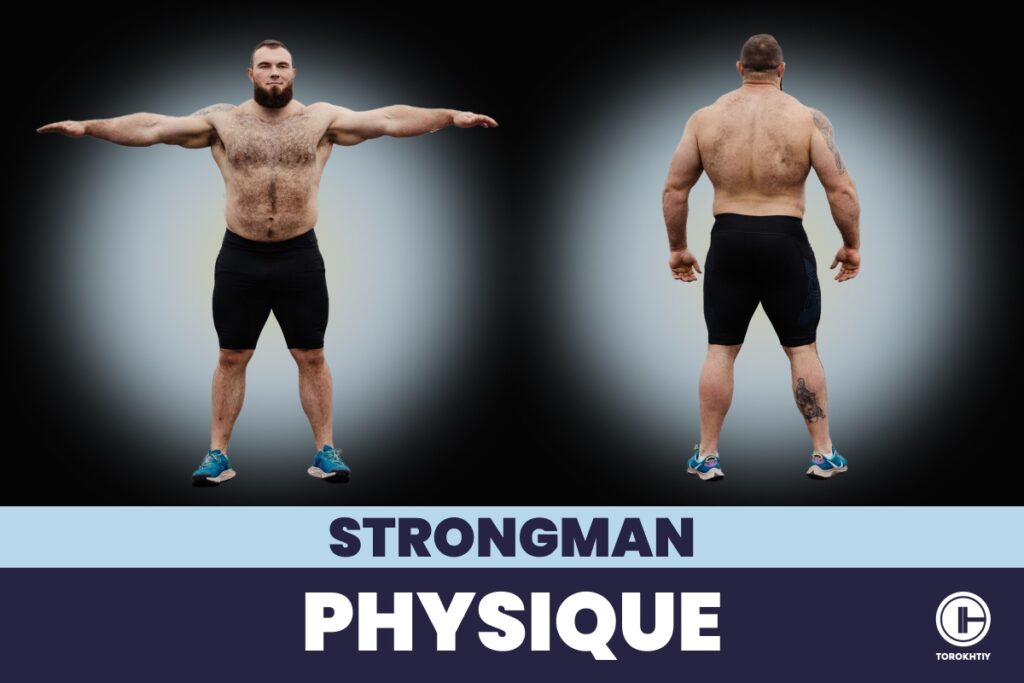
Strongman Physique – Overview
Strongman competition is a synonym for extraordinary physical strength and ultimate athletic skills.
With progress, in the nineteenth century, in Europe, strongman competitions became more popular, thus were organized in circuses and theaters, where athletes competed in physical endurance tests, like pulling carriages or lifting heavy items.
Since then, WSM contests transformed from a strength show into a competitive discipline with defined regulations.
The International Force Sports Federation (IFSA), which was founded in the 1970s, regulated Strongman competitions all over the world. Modern Strongman competitions involve a series of events that test the strength, endurance, and power of athletes, such as lifting boulders, towing trucks, and throwing heavy objects.
In recent years, Strongman competition gained more popularity, attracting athletes from weightlifting and powerlifting who seek to test their strength in unique events.
Athletes with a strongman body type tend to take up strength-oriented activities such as powerlifting events involving lifting heavy items and performing physically demanding movements, e.g., carrying, pulling, pressing objects, or flipping tires.
To maintain proper body construction, athletes try to follow a high-calorie diet, rich in protein and carbs to support muscle growth and repair muscle tissues after a tough workout.
Additionally, they should follow regular strength training that involves specific muscle groups, building power and endurance at a time. However, not every athlete wants to look like a regular bodybuilder with oversized deltoids and a low body fat percentage.
Research results indicated that low body fat, which is less than 10% of body fat was rarely seen in large-sized male athletes over 100 kg body mass. The larger the body mass, the higher the fat-free mass.
If a strongman doesn’t develop strength, muscle mass, and density over a long period of time, he’ll probably just look fat. Compound movements, which involve multiple muscles at a time, and huge amounts of calories will become handy.
Indeed, strongmen are strong, but they don’t care about a sculpted fat-free body. Adding more cardio and mobility work will enable a strongman to keep sharp and maintain muscle mass.
How Body Features Affect Success Gain While Strongman Training?
As usual, a strongman’s body is associated with a large and muscular physique, so an athlete is capable of lifting immense weights and possesses an impressive mastery of strength.
It needs to be mentioned that fat percentage may differ for various strength sports. For instance, bodybuilding requires low percentage of fat as it has a specific training program for competition. While in the off-season period, bodybuilders maintain 15% of fat.
For strength speed-specific sports, such a percent rate may lead to injury, so the fat rate should be higher. At the same time, excessive fat is a big problem because the body uses only carbs, namely glycogen, during training sessions. Hence, fat is not an energy source for strength workout.
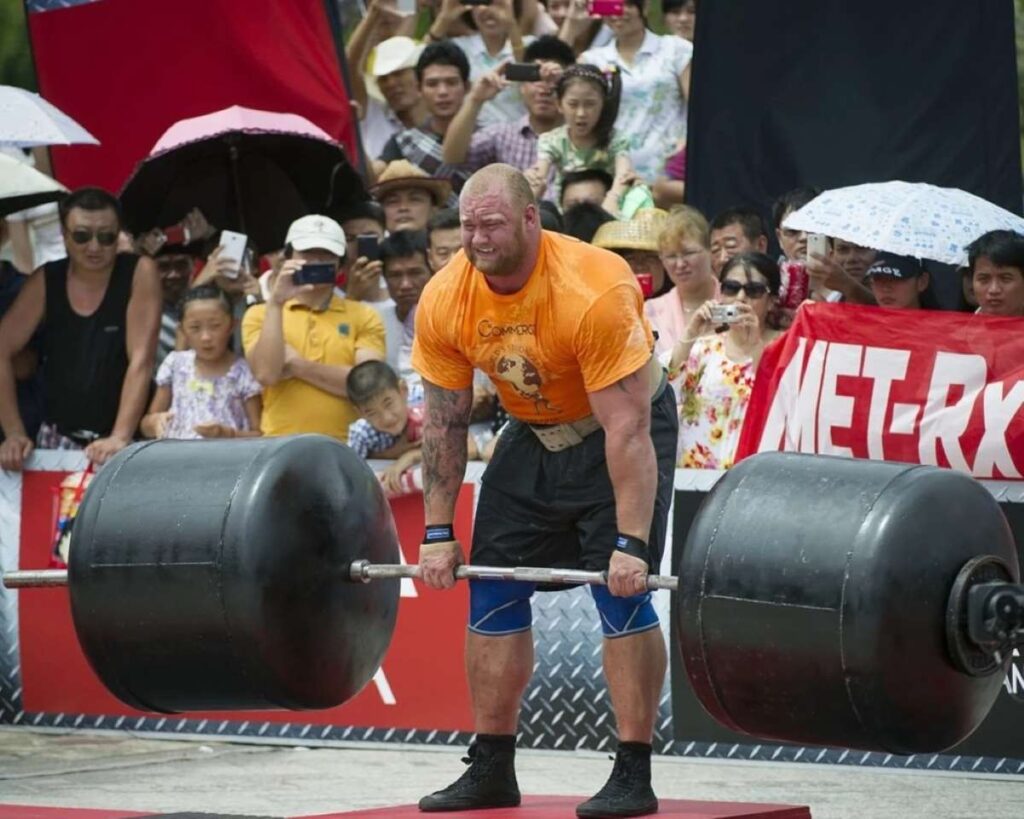
The thing is that while eating we consume more fat than needed, which is highly energy-producing. During anaerobic strength training, the body takes one glucose molecule and produces two ATP molecules.
While aerobic training with up to 120 BPM, the body takes one glucose molecule as well, but produces 40 ATP. This means that the body requires a great amount of carbs to get energy source during strength workout.
It’s possible to use fat deposits while aerobic training, namely during oxidation, when the body takes one fat molecule and gives 120 ATP energy. It’s 60 times more than during strength workout with carbs consumption. Therefore, it’s difficult to burn odd fat with proper nutrition.
Proper body composition, including the dynamics of muscle, bone health, fat, and water, influences any athletic performance. For example, a strongman, Mitchell Hooper, claims that strength is more than just muscle mass.
By the way, Hooper has a lower body fat percentage, compared to a typical strongman athlete. While a strongman body fat percentage is 30% at the maximum, with a fat mass of 30.9 ± 11.1 kg. So, he proves that low body fat can enhance body composition and inner strength demonstrating raw power and stamina.
Why are strongmen fat is that they have a strong core: strong guys often look fatter than they are because they have a ton of muscle around their trunks to keep their bodies stable while doing heavy presses, squats, and deadlifts.
To achieve and maintain a strongman physique, an athlete should follow a proper nutrition and training plan: consume a surplus of calories, alongside heavy free-weight training, with a particular focus on functional strength development.
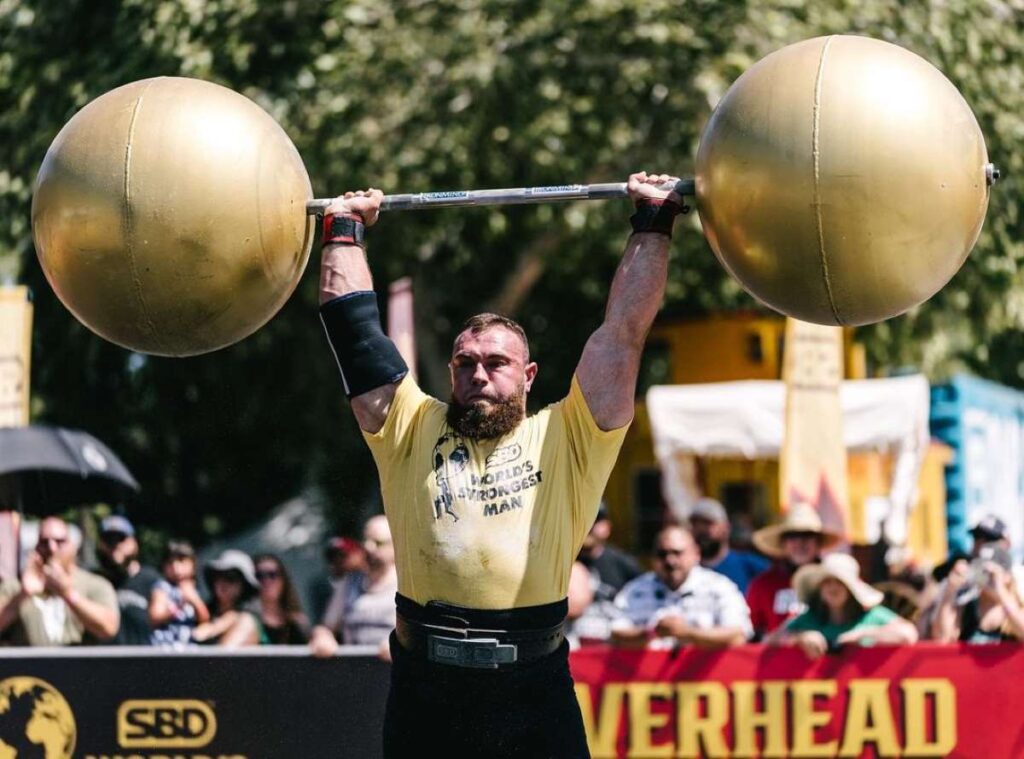
Basic Attributes of a Strongman’s Physique and Its Influence on Performance
The strongman’s body is an embodiment of a large and muscular body mass. Usually, such a body type is associated with athletes participating in powerlifting and strongman competitions. However, not all strongmen are big. Let’s define the peculiarities of strongman’s body construction.
1. Overall Muscularity
The strongman body features broad shoulders, thick arms and legs, a well-defined chest, and wide lean back that is the result of years of consistent training, proper diet, and a commitment to a healthy lifestyle.
This muscle mass provides the strength needed to perform the various lifting and carrying events in strongman competitions.
High skeletal muscle mass and excellent strength output capacity are also vital for training efficiency. While a layer of fat is present covering the abdominal muscles. Meaning, that the much-coveted six-pack is not visible.
Strongmen may vary in their physique since they can compete in different weight classes – lightweight that is 75 kg to 90 kg; middleweight – 90-118 kg; and heavyweight – over 118 kg.
Professional athletes manage to get their results due to their nature, while events of the pro class require great endeavours and strength, thus only super strong athletes manage to win.
To get big muscles, it’s important to have strong tendons that differ them from bodybuilders. Muscle mass tissue volume depends on sarcoplasmic hypertrophy where lots of carbs (glycogen) are burned.
Then, it should be returned to the muscles back, that is why muscles are gradually growing becoming an energy block for further workouts.
The actual appearance of strongmen may vary in proportions and body fat percentage. Still, the common feature of a strongman physique is a high amount of muscle mass capable of producing significant force despite the resistance.
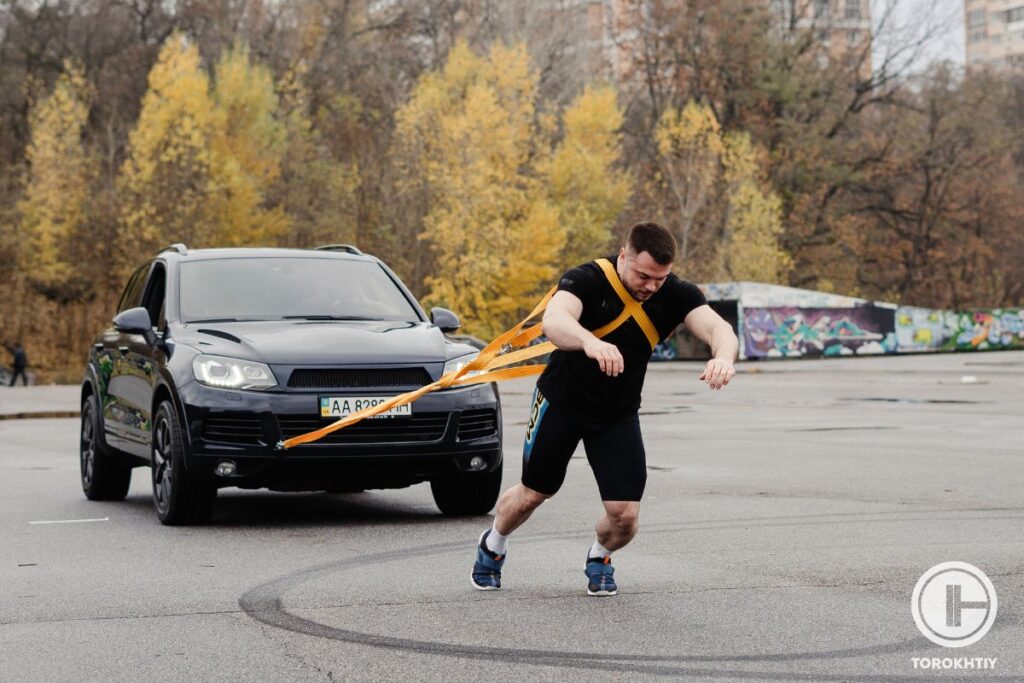
2. Strength Generation
Having exceptional strength is the key to lifting and moving heavy objects, e.g., Atlas stones, logs, or kegs. To develop this strength it’s essential to perform a combination of some weight training, powerlifting, and strongman-specific training.
It’s also important to generate force quickly to be able to perform explosive movements like lifting a heavy weight off the ground or pushing a sled across a distance. To keep this capability at a proper level, it’s possible to perform specific exercises like cleans, snatches, or plyometrics.
3. Mobility and Flexibility
Despite being muscular and big, strongmen also need to be relatively flexible and agile to perform events quickly, preserving high concentration along the whole workout or competition.
However, besides the natural gifts, it’s crucial to preserve the immense systematic work of the training regime. It may happen that physically strong giants can be defeated by athletes of a short stature who possess good technique.
Strongmen Comparison With Other Strength Training Sports
Developing strength and body muscles is the key goal of these three training types. While benefits may extend to delivering strong bones, healthy joints, firing metabolism, and even boosting brain power, strength-oriented training is growing in popularity in the last few years.
There are different ways to develop strength and one of them refers to muscle volume increase as it influences the athlete’s size directly. For example, in bodybuilding, apparently all winners are 1.8 meters tall, which is a gold standard among bodybuilders.
While in strongman competitions, the majority of athletes are tall, around 2 meters height. For instance, Champion strongman and bodybuilding leader Hafþór Júlíus Björnsson has an enviable physique. His height is 2.06 meters.
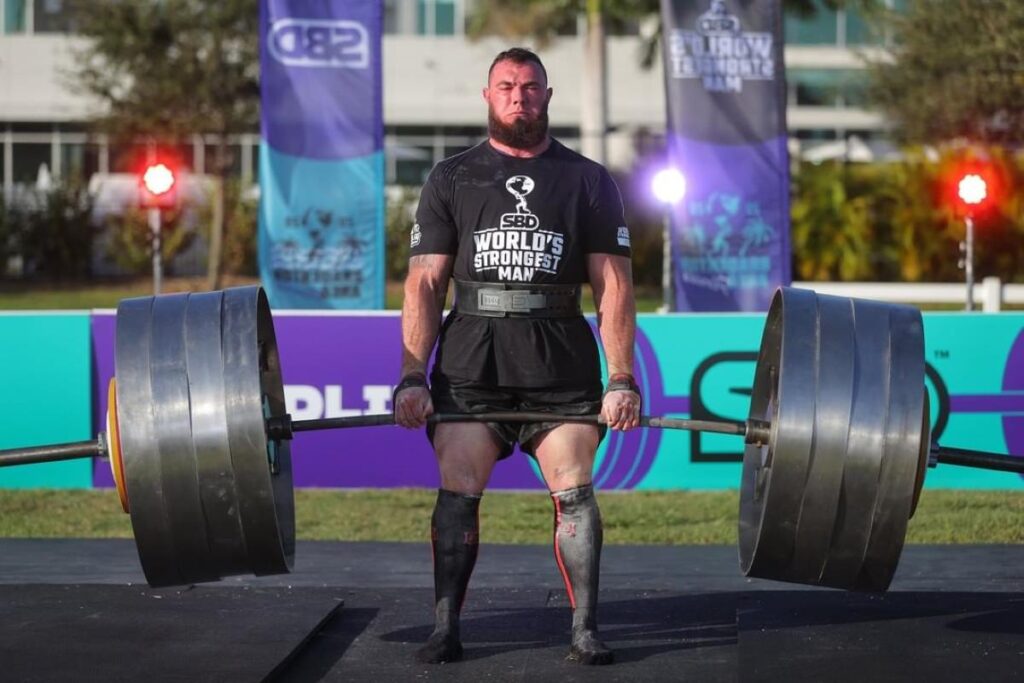
1. Strongman vs Powerlifting
Strongman and powerlifting are both strength-oriented sports that involve lifting heavy weights, but they have some key differences in terms of the events, equipment used, and training focus.
As usual, Strongman competitions involve a variety of events that test overall endurance and athleticism. While powerlifting competitions consist of three main lifts – squat, bench press, and deadlift. The goal is to lift as much weight as possible.
Speaking about the equipment, Strongman competitions involve specialized equipment such as atlas stones, farmer’s walk handles, log bars, etc.
While powerlifting competitions require powerlifting barbells, competition benches, and squat racks. It’s possible to use supportive lifting equipment like lifting belts, knee sleeves, and wrist wraps to promote performance and protect athletes from injuries.
Strongman events concentrate on overall strength, endurance, and functional fitness to prepare for the varied challenges of strongman events. Powerlifting focuses on improving strength in three lifts – squat, bench press, and deadlift.
In Strongman events, the mechanical stimulus is higher than in powerlifting, there is a greater range of options to involve muscles in the extreme conditions. Thus, it’ll improve athletes’ physical capabilities for their maximum stimulation.
2. Strongman vs Bodybuilding
Bodybuilding is a form of exercise that focuses on building muscle mass and strength via weight lifting and resistance training. Unlike strongman, which concentrates on raw power, bodybuilding prioritizes creating aesthetic muscularity. It’ll fit those athletes who want to build their physiques, increase strength, and endurance.
Bodybuilding emphasizes hypertrophy and muscle definition, while Strongman aims to develop power, endurance, and maximum strength. What about the required equipment, bodybuilding requires barbells, dumbbells, and various machines while Strongman training involves large objects such as kegs, tires, stones, and logs.
If your aim is to build muscles or compete in bodybuilding contests, then bodybuilding may be the right option for you. However, considering the difference in events in both sports, bodybuilding has no competitive movements to perform for a defined time or distance.
The thing is bodybuilders have a lower fat and liquid rate in their bodies, especially before the competition period. Thus, it may be quite risky to work out with extreme weights.
Still, a common thing for strongmen and bodybuilders is to follow a well-considered nutrition plan to gain greater results.
3. Strongman vs Functional Fitness
The difference between these two training styles is quite obvious. Functional training consists of compound exercises that involve multiple muscle groups, aiming to strengthen movement patterns we perform every day, i.e., walking, pushing, pulling, or jumping.
These two disciplines have different sports goals, thus athletes have different body constructions. A strongman can implement functional fitness exercises to recover after tough workouts, be more flexible, improve cardiovascular heath and aerobic skills to control better own body.
It can be performed using bodyweight or free weights, but it rarely includes machines as powerlifting or bodybuilding do. This is because functional training aims to minic and strengthen natural movement patterns.
3 Training Methods to Develop a Strongman Physique
To start with, everyone can become a Strongman. Strongman exercises are for everyone, so if you’re looking to develop power, increase muscle mass, and be able to carry heavy weights, you can try a strongman-like training routine.
Although, it’s better to take up Strongman having a background in other strength sports like weightlifting or bodybuilding. It’s better to start gradually following a consistent training plan. The fact is that 20-30% are Strongman exercises, while the rest refer to a strength basis common to bodybuilding and weightlifting.
No matter whether you’re a beginner, or are already training hard on a regular basis, Strongman workout will work for you making you stronger. There’s a great variety of strongman exercises, so choose them depending on your goals and movement competency.
Don’t forget about consistency of training as it’s incredibly taxing and needs a lot of time and planning if you want to get the most out of it.
1. Building Power
Deadlifting is a perfect way to become stronger. It’s good for your core and grip strength and overall athletic development. This movement works your whole body, especially the posterior chain: glutes, hamstrings, and lower back. Deadlift is a solid foundational movement to boost your stamina for other strongman training workouts.
Another variant is performing Atlas stones. Regular training with an Atlas stone will build strength in your erectors, lats, pecs, rhomboids, and shoulders. It’s supposed to be a meaty movement for meaty athletes.
2. Developing Speed and Force
Some strongman exercises like sled pushing, farmer’s walk, and yoke carry are some of the most heart-involving, leg-pumping training movements for building overall strength and endurance. These movements involve almost all muscle groups just by pushing enough weight or pushing lighter weight over the distance.
When you think of raw power, the idea of pushing something heavy definitely comes to mind. So, these exercises give a great stimulus to build strength, speed, force, and body responsiveness.
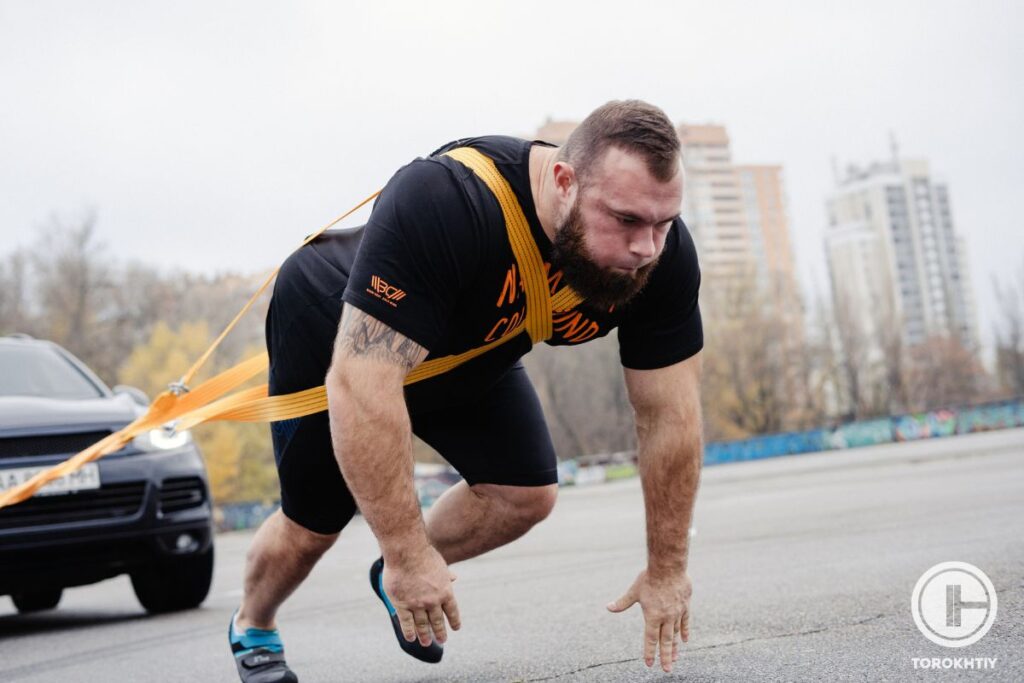
3. Sticking to a Stable Workout Routine
To prepare your body for the strongman, strength training involving circuits is a good option for a beginner. It’s also useful to add up some compound movements, and accessory exercises, and end up with a power circuit.
For instance, you can arrange the following scheme for your circuit workout:
- Deadlifts – 5 sets, 3 reps with 3-minute rest
- Walking lunges – 3 sets, 8 reps with 2 minutes rest
- Dips – 3 sets, 8 reps with 2-minute rest
- Atlas Stones (or sandbags) 3 sets as many reps in 60 seconds
- Flat bench Press – 5 sets of 2-8 reps pyramid up in weight to a heavy top set
Follow us!

Free!
Get a 2-week Weightlifting Program as a bonus for the subscription to kickstart your training plan!

Free!
4. Proper Nutrition and Recovery
To gain the desired Strongman physique and strength indications an athlete needs to build up a well-considered nutrition program and dedicate enough time for recovery. These steps will enable the body to renew its physical capabilities by getting better strength levels.
Since strongman training is some of the most demanding, there are a multitude of options for recovering faster to increase training volume, intensity, and frequency, thus getting the coveted physique.
Proper nutrition will provide the body with the necessary macro and micronutrients to repair and grow muscle tissue. Carbs are crucial for energy replenishment, adequate hydration is also essential for muscle recovery; timing of meals is highly crucial for strongmen.
On the contrary, overtraining and absence of proper diet will impact athlete’s condition negatively. By the way, the study indicated that there’s a relationship between anthropometrics and maximal isoinertial strength to strongman performance in novice strongman athletes.
Semiprofessional rugby players with resistance training and some strongman training experience (weight 102.6 ± 10.8 kg, height 184.6 ± 6.5 cm) were assessed for anthropometry (height, body composition, and girth measurements), maximal isoinertial performance (bench press, squat, deadlift, and power clean), and strongman performance (tire flip, log clean, and press, truck pull, and farmer’s walk).
The result of this research showed clear moderate to very large relationships existed between performance in all strongman events and the squat, indicating the importance of maximal squat strength for strongman competitors.
It’s important to remember that strongman training is incredibly demanding that requires time, ultimate dedication, and desire to become stronger through tough workout sessions.
Conclusion
A well-balanced combination of training, nutrition, and recovery is the key for gaining a quality strongman physique without damaging the overall athlete’s health.
Need an expert’s help of what regime to follow to maintain a proper body to benefit from effective training? Then write back below.
References:
- Kraemer, William J.; Caldwell, Lydia K.; Post, Emily M.”Body Composition in Elite Strongman Competitors”, Journal of Strength and Conditioning Research 34(12) (2020): p. 3326-3330.
- Abe T, Bell ZW, Wong V, Spitz RW, Loenneke JP. “Why is low body fat rarely seen in large-sized male athletes?” American journal of human biology, no. 32(6) (2020), .
- Hindle BR, Lorimer A, Winwood P, Keogh JWL. “The biomechanics and applications of strongman exercises: A systematic review.” Sports Medicine-Open 5 (2019): 49.
- Paul W Winwood, Justin W L Keogh, Nigel K Harris. “Interrelationships between strength, anthropometrics, and strongman performance in novice strongman athletes”, Journal of Strength and Conditioning Research, no.26(2) (2012): p. 513-22.
- Winwood PW, Keogh JW, Harris NK. The strength and conditioning practices of strongman competitors. Journal of Strength and Conditioning Research, no.25 (2011): p. 3118–3128.
- Photos are made by Torokhtiy Media team.
Why Trust Us?
With over 20 years in Olympic weightlifting, strength training, nutrition coaching, and general fitness our team does its best to provide the audience with ultimate support and meet the needs and requirements of advanced athletes and professional lifters, as well as people who strive to open new opportunities and develop their physical capabilities with us.
By trusting the recommendations of our certified experts in coaching, nutrition, and sports training programming, as well as scientific consultants, and physiotherapists, we provide you with thorough, well-considered, and scientifically proven content. All the information given in the articles concerning workout programming, separate exercises, and athletic performance, in general, is based on verified data.
The product testing process is described in more detail here.
Author: Sergiy Osipchyk
Strongman Coach,
Former coach of Oleksiy Novikov and Pavlo Nakonechnyy
Strongman Experience: 10+ years
Sergiy has been involved in strength sports since he was 10 years old, and already started coaching when he was just 15 years old.
He helps clients of any age and experiences achieve results using an individual approach, daily process control, consultation and training knowledge and techniques, total experience is more than 20,000 individual training sessions.
Sergiy has trained a roster of renowned PRO strongman athletes including Oleksii Novikov, Pavlo Nakonechnyy and many other.



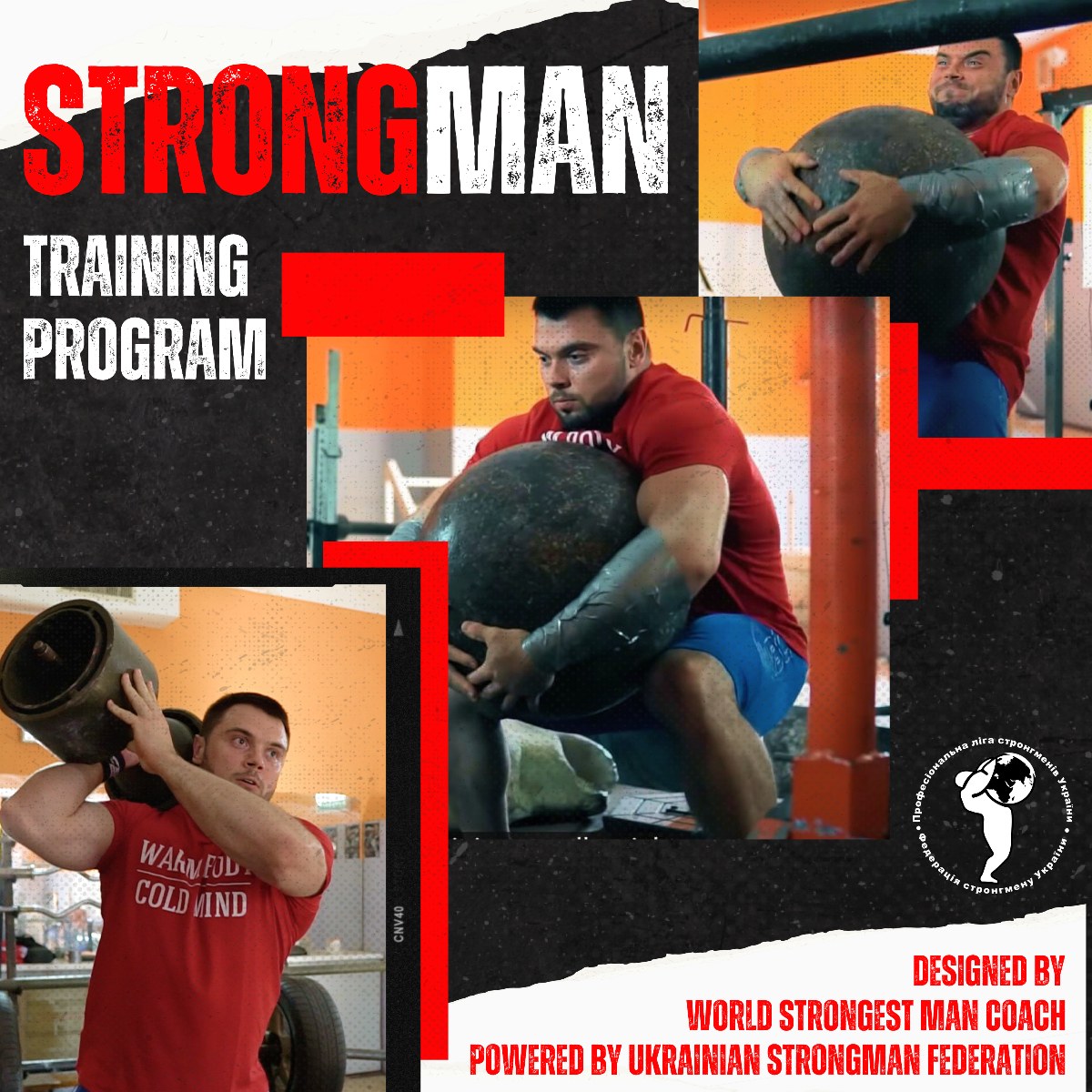
Still have questions after reading our article? Unlock your full potential by engaging with our experts and community! Don’t hesitate — leave a comment below and Sergiy Osipchyk will provide a personalized answer and insights to help you reach your goals.